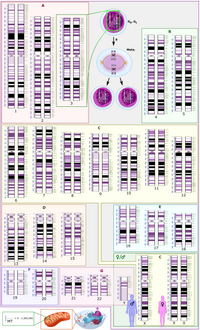
Photo from wikipedia
Multiple applications of genome editing by CRISPR-Cas9 necessitate stringent regulation and Cas9 variants have accordingly been generated whose activity responds to small ligands, temperature or light. However, these approaches are… Click to show full abstract
Multiple applications of genome editing by CRISPR-Cas9 necessitate stringent regulation and Cas9 variants have accordingly been generated whose activity responds to small ligands, temperature or light. However, these approaches are often impracticable, for example in clinical therapeutic genome editing in situ or gene drives in which environmentally-compatible control is paramount. With this in mind, we have developed heritable Cas9-mediated mammalian genome editing that is acutely controlled by the cheap lysine derivative, Lys(Boc) (BOC). Genetic code expansion permitted non-physiological BOC incorporation such that Cas9 (Cas9BOC) was expressed in a full-length, active form in cultured somatic cells only after BOC exposure. Stringently BOC-dependent, heritable editing of transgenic and native genomic loci occurred when Cas9BOC was expressed at the onset of mouse embryonic development from cRNA or Cas9BOC transgenic females. The tightly controlled Cas9 editing system reported here promises to have broad applications and is a first step towards purposed, spatiotemporal gene drive regulation over large geographical ranges.
Journal Title: Scientific Reports
Year Published: 2018
Link to full text (if available)
Share on Social Media: Sign Up to like & get
recommendations!